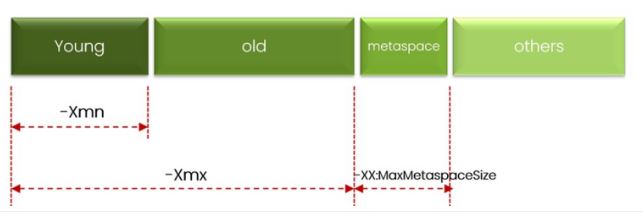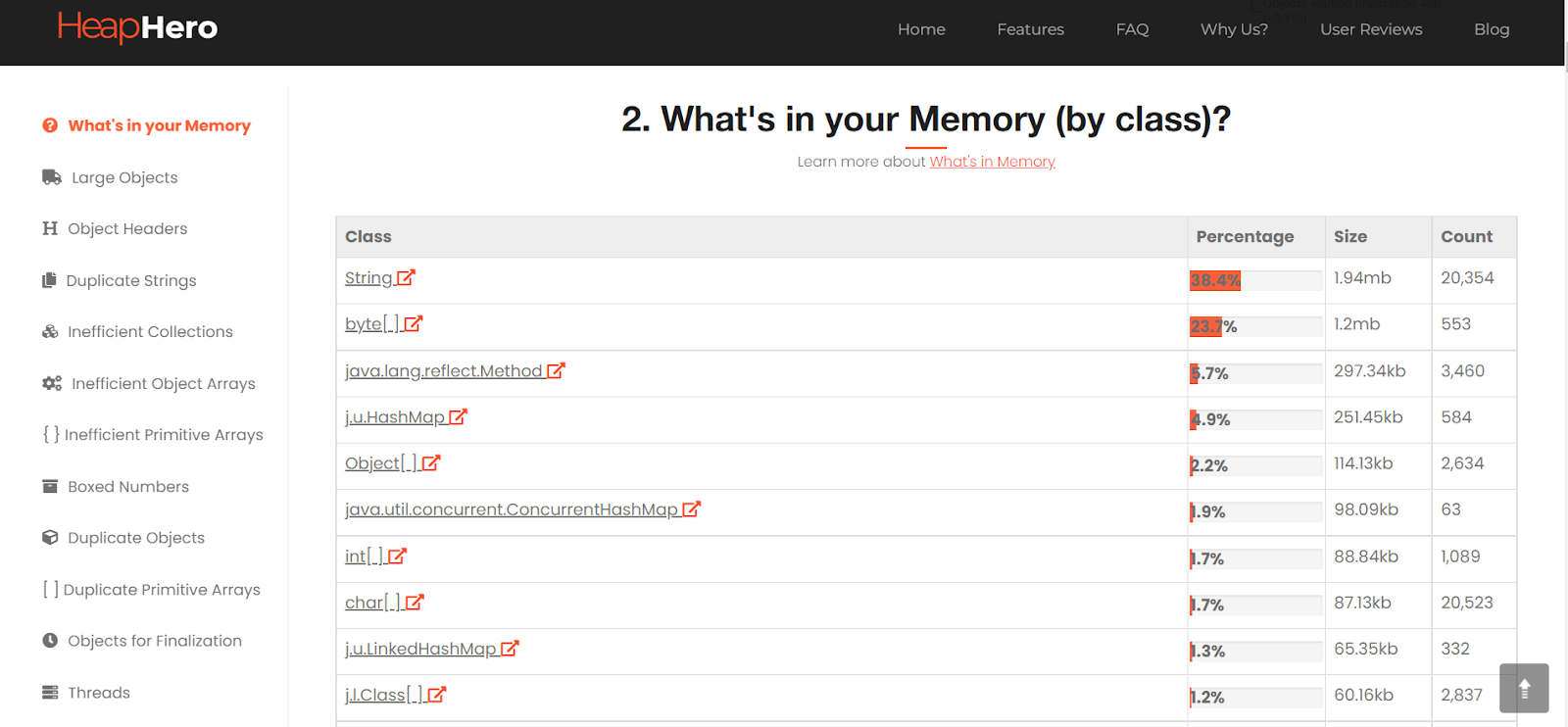Inspect the Contents of the Java Metaspace Region
Learn more about JVM and how to inspect the contents of the Java Metaspace region.
Join the DZone community and get the full member experience.
Join For FreeJVM Memory has the following regions:
- Young Generation
- Old Generation
- Metaspace
- Others region

Fig: JVM memory regions
To see what objects are stored in what region, you may refer to this video clip. Sometimes your application might run into ‘java.lang.OutOfMemoryError: Metaspace’ as discussed in this post. In such circumstances, you might want to see what the contents are loaded in the Metaspace region of the JVM. In nutshell, the Metaspace region in the JVM memory contains the class metadata definitions that are required to execute your application. If you want to understand what class metadata definitions mean, you can refer to this documentation. It has intense details, you may not have to understand all the details of it. Basically, if you can understand what are the classes that are loaded into memory, it will give a good idea what are the contents that are present in the Metaspace region of the JVM memory. In this post let’s explore the options that are available to see the classes that are loaded into the Metaspace.
Below are the options to see the classes that are loaded in the Metaspace:
- -verbose:class
- -Xlog:class+load
- jcmd GC.class_histogram
- Programmatic approach
- Heap Dump analysis
Let’s discuss each option in detail in this post.
1. -Verbose: Class
If you are running on Java version 8 or below then you can use this option. When you pass the ‘-verbose:class’ option to your application during startup, it will print all the classes that are loaded into memory. Loaded classes will be printed in the standard error stream (i.e. console, if you aren’t routing your error stream to a log file).
java {app_name} -verbose:classFollowing is the sample output of the open source BuggyApp program when ‘-verbose:class’ argument is passed:
[Opened C:\Program Files\Java\jre1.8.0_171\lib\rt.jar]
[Loaded java.lang.Object from C:\Program Files\Java\jre1.8.0_171\lib\rt.jar]
[Loaded java.io.Serializable from C:\Program Files\Java\jre1.8.0_171\lib\rt.jar]
[Loaded java.lang.Comparable from C:\Program Files\Java\jre1.8.0_171\lib\rt.jar]
[Loaded java.lang.CharSequence from C:\Program Files\Java\jre1.8.0_171\lib\rt.jar]
[Loaded java.lang.String from C:\Program Files\Java\jre1.8.0_171\lib\rt.jar]
[Loaded java.lang.reflect.AnnotatedElement from C:\Program
Files\Java\jre1.8.0_171\lib\rt.jar]
[Loaded java.lang.reflect.GenericDeclaration from C:\Program
Files\Java\jre1.8.0_171\lib\rt.jar]
[Loaded java.lang.reflect.Type from C:\Program Files\Java\jre1.8.0_171\lib\rt.jar]
[Loaded java.lang.Class from C:\Program Files\Java\jre1.8.0_171\lib\rt.jar]
[Loaded java.lang.Cloneable from C:\Program Files\Java\jre1.8.0_171\lib\rt.jar]
[Loaded java.lang.ClassLoader from C:\Program Files\Java\jre1.8.0_171\lib\rt.jar]
[Loaded java.lang.System from C:\Program Files\Java\jre1.8.0_171\lib\rt.jar]
[Loaded java.lang.Throwable from C:\Program Files\Java\jre1.8.0_171\lib\rt.jar]
[Loaded java.lang.Error from C:\Program Files\Java\jre1.8.0_171\lib\rt.jar]
[Loaded java.lang.ThreadDeath from C:\Program Files\Java\jre1.8.0_171\lib\rt.jar]
[Loaded java.lang.Exception from C:\Program Files\Java\jre1.8.0_171\lib\rt.jar]
[Loaded java.lang.RuntimeException from C:\Program Files\Java\jre1.8.0_171\lib\rt.jar]
[Loaded java.lang.SecurityManager from C:\Program Files\Java\jre1.8.0_171\lib\rt.jar]
[Loaded java.security.ProtectionDomain from C:\Program Files\Java\jre1.8.0_171\lib\rt.jar]
[Loaded java.security.AccessControlContext from C:\Program
Files\Java\jre1.8.0_171\lib\rt.jar]
[Loaded java.security.SecureClassLoader from C:\Program
Files\Java\jre1.8.0_171\lib\rt.jar]
[Loaded java.lang.ReflectiveOperationException from C:\Program
Files\Java\jre1.8.0_171\lib\rt.jar]
[Loaded java.lang.ClassNotFoundException from C:\Program
Files\Java\jre1.8.0_171\lib\rt.jar]
[Loaded java.lang.LinkageError from C:\Program Files\Java\jre1.8.0_171\lib\rt.jar]
[Loaded java.lang.NoClassDefFoundError from C:\Program Files\Java\jre1.8.0_171\lib\rt.jar]
[Loaded java.lang.ClassCastException from C:\Program Files\Java\jre1.8.0_171\lib\rt.jar]
[Loaded java.lang.ArrayStoreException from C:\Program Files\Java\jre1.8.0_171\lib\rt.jar]
[Loaded java.lang.VirtualMachineError from C:\Program Files\Java\jre1.8.0_171\lib\rt.jar]
[Loaded java.lang.OutOfMemoryError from C:\Program Files\Java\jre1.8.0_171\lib\rt.jar]
[Loaded java.lang.StackOverflowError from C:\Program Files\Java\jre1.8.0_171\lib\rt.jar]
2. -Xlog:Class+Load
If you are running on Java version 9 or above then you can use this option. When you pass the ‘-Xlog:class+load’ option to your application during startup, it will print all the classes that are loaded into memory. Loaded classes will be printed in the file path you have configured.
java {app_name} -Xlog:class+load=info:/opt/log/loadedClasses.txtFollowing is the sample output of a java program when ‘-Xlog:class+load’ argument is passed:
[0.004s][info][class,load] opened: /home/ec2-user/jdk-9.0.4/lib/modules
[0.006s][info][class,load] java.lang.Object source: jrt:/java.base
[0.007s][info][class,load] java.io.Serializable source: jrt:/java.base
[0.007s][info][class,load] java.lang.Comparable source: jrt:/java.base
[0.007s][info][class,load] java.lang.CharSequence source: jrt:/java.base
[0.007s][info][class,load] java.lang.String source: jrt:/java.base
[0.007s][info][class,load] java.lang.reflect.AnnotatedElement source: jrt:/java.base
[0.007s][info][class,load] java.lang.reflect.GenericDeclaration source: jrt:/java.base
[0.007s][info][class,load] java.lang.reflect.Type source: jrt:/java.base
[0.008s][info][class,load] java.lang.Class source: jrt:/java.base
[0.008s][info][class,load] java.lang.Cloneable source: jrt:/java.base
[0.008s][info][class,load] java.lang.ClassLoader source: jrt:/java.base
[0.008s][info][class,load] java.lang.System source: jrt:/java.base
[0.008s][info][class,load] java.lang.Throwable source: jrt:/java.base
[0.008s][info][class,load] java.lang.Error source: jrt:/java.base
[0.008s][info][class,load] java.lang.ThreadDeath source: jrt:/java.base
[0.008s][info][class,load] java.lang.Exception source: jrt:/java.base
[0.008s][info][class,load] java.lang.RuntimeException source: jrt:/java.base
[0.008s][info][class,load] java.lang.SecurityManager source: jrt:/java.base
[0.008s][info][class,load] java.security.ProtectionDomain source: jrt:/java.base
[0.009s][info][class,load] java.security.AccessControlContext source: jrt:/java.base
[0.009s][info][class,load] java.security.SecureClassLoader source: jrt:/java.base
[0.009s][info][class,load] java.lang.ReflectiveOperationException source: jrt:/java.base
[0.009s][info][class,load] java.lang.ClassNotFoundException source: jrt:/java.base
[0.009s][info][class,load] java.lang.LinkageError source: jrt:/java.base
[0.009s][info][class,load] java.lang.NoClassDefFoundError source: jrt:/java.base
[0.009s][info][class,load] java.lang.ClassCastException source: jrt:/java.base
[0.009s][info][class,load] java.lang.ArrayStoreException source: jrt:/java.base
[0.009s][info][class,load] java.lang.VirtualMachineError source: jrt:/java.base
[0.009s][info][class,load] java.lang.OutOfMemoryError source: jrt:/java.base
[0.009s][info][class,load] java.lang.StackOverflowError source: jrt:/java.base
[0.009s][info][class,load] java.lang.IllegalMonitorStateException source: jrt:/java.base
[0.009s][info][class,load] java.lang.ref.Reference source: jrt:/java.base
[0.009s][info][class,load] java.lang.ref.SoftReference source: jrt:/java.base
[0.009s][info][class,load] java.lang.ref.WeakReference source: jrt:/java.base
[0.009s][info][class,load] java.lang.ref.FinalReference source: jrt:/java.base
[0.009s][info][class,load] java.lang.ref.PhantomReference source: jrt:/java.base
[0.009s][info][class,load] java.lang.ref.Finalizer source: jrt:/java.base
[0.009s][info][class,load] java.lang.Runnable source: jrt:/java.base
[0.009s][info][class,load] java.lang.Thread source: jrt:/java.base
[0.009s][info][class,load] java.lang.Thread$UncaughtExceptionHandler source:
jrt:/java.base
[0.009s][info][class,load] java.lang.ThreadGroup source: jrt:/java.base
[0.010s][info][class,load] java.util.Map source: jrt:/java.base
[0.010s][info][class,load] java.util.Dictionary source: jrt:/java.base
[0.010s][info][class,load] java.util.Hashtable source: jrt:/java.base
[0.010s][info][class,load] java.util.Properties source: jrt:/java.base
[0.010s][info][class,load] java.lang.Module source: jrt:/java.base
[0.010s][info][class,load] java.lang.reflect.AccessibleObject source: jrt:/java.base3. Jcmd Gc.class_histogram
JDK contains a tool called ‘jcmd’. You can invoke this tool when JVM is running to inspect the contents of the Metaspace region. When you invoke this tool with ‘GC.class_histogram’ argument, it will print the list of classes that are loaded into the memory. You can invoke this tool in two modes:
A. Print Loaded Classes on the Console
jcmd {pid} GC.class_histogramWhen you invoke the ‘jcmd’ as shown above, it will print all the loaded classes in the console. Here {pid} is the process id of your java application.
B. Print Loaded Classes on a File
jcmd {pid} GC.class_histogram filename={file-path}When you invoke the ‘jcmd’ as shown above, it will print all the loaded classes in the file path specified in the ‘filename’ argument. Here {pid} is the process id of your java application.
Here is a blog post which helps you to identify the process id quickly.
Following is the sample output of the open source BuggyApp program when ‘jcmd GC.class_histogram’ argument is passed:
jcmd 19684 GC.class_histogram
19684:
num #instances #bytes class name
----------------------------------------------
1: 143036 75523008 [Ljavassist.bytecode.ConstInfo;
2: 718060 70032224 [C
3: 1573553 50353696 java.util.HashMap$Node
4: 430124 24732832 [Ljava.lang.Object;
5: 1001290 24030960 javassist.bytecode.Utf8Info
6: 858268 20598432 java.util.ArrayList
7: 718037 17232888 java.lang.String
8: 144011 14987488 java.lang.Class
9: 143081 11447152 [Ljava.util.HashMap$Node;
10: 143036 9154304 javassist.bytecode.ClassFile
11: 143035 9154240 javassist.CtNewClass
12: 286124 6892400 [B
13: 143085 6868080 java.util.HashMap
14: 286078 6865872 javassist.bytecode.ClassInfo
15: 143036 6865728 [[Ljavassist.bytecode.ConstInfo;
16: 143049 5721960 javassist.bytecode.MethodInfo
17: 143042 5721680 javassist.bytecode.CodeAttribute
18: 143323 4586336 java.util.Hashtable$Entry
19: 143038 4577216 java.lang.ref.WeakReference
20: 143036 4577152 javassist.bytecode.ConstPool
21: 143045 3433080 javassist.bytecode.MethodrefInfo
22: 143045 3433080 javassist.bytecode.NameAndTypeInfo
23: 143042 3433008 javassist.bytecode.ExceptionTable
24: 143036 3432864 javassist.bytecode.LongVector
25: 143036 3432864 javassist.bytecode.SourceFileAttribute
26: 143622 2323336 [I
27: 10 788688 [Ljava.util.Hashtable$Entry;
28: 642 20544 java.util.concurrent.ConcurrentHashMap$Node
29: 244 13664 java.lang.invoke.MemberName
30: 341 10912 sun.misc.FDBigInteger
31: 212 8480 java.lang.ref.SoftReference
32: 140 8400 [Ljava.lang.ref.SoftReference;
33: 234 7488 java.lang.invoke.LambdaForm$Name
34: 176 7040 java.lang.invoke.MethodType
35: 256 6144 java.lang.Long
36: 16 6016 java.lang.Thread
37: 173 5880 [Ljava.lang.Class;
38: 366 5856 java.lang.Object
39: 177 5664 java.lang.invoke.MethodType$ConcurrentWeakInternSet$WeakEntry
40: 10 5280 [Ljava.util.concurrent.ConcurrentHashMap$Node;
41: 256 4096 java.lang.Byte
42: 256 4096 java.lang.Integer
43: 256 4096 java.lang.Short
44: 73 4088 java.lang.invoke.MethodTypeForm
45: 82 3808 [Ljava.lang.invoke.LambdaForm$Name;
46: 77 3696 java.lang.invoke.LambdaForm4. Programmatic Approach
You can also use a programmatic approach to print the classes that are loaded into the memory. Open source Guava library provides APIs to print the loaded classes. Below is the code sample that leverages the Guava library to print the loaded classes in the memory:
ClassPath classPath = ClassPath.from(BuggyAppLoader.class.getClassLoader());
Set<ClassInfo> classes = classPath.getAllClasses();
for(ClassInfo classInfo : classes) {
logger.info(classInfo.getName());
}org.apache.catalina.core.AsyncContextImpl
org.apache.catalina.core.AsyncListenerWrapper
org.apache.catalina.core.Constants
org.apache.catalina.core.ContainerBase$ContainerBackgroundProcessor
org.apache.catalina.core.ContainerBase$PrivilegedAddChild
org.apache.catalina.core.ContainerBase$StartChild
org.apache.catalina.core.ContainerBase$StartStopThreadFactory
org.apache.catalina.core.ContainerBase$StopChild
org.apache.catalina.core.ContainerBase
org.apache.catalina.core.DefaultInstanceManager$1
org.apache.catalina.core.DefaultInstanceManager$2
org.apache.catalina.core.DefaultInstanceManager$3
org.apache.catalina.core.DefaultInstanceManager$AnnotationCacheEntry
org.apache.catalina.core.DefaultInstanceManager$AnnotationCacheEntryType
org.apache.catalina.core.DefaultInstanceManager
org.apache.catalina.core.JreMemoryLeakPreventionListener
org.apache.catalina.core.NamingContextListener
org.apache.catalina.core.StandardContext$1
org.apache.catalina.core.StandardContext$ContextFilterMaps
org.apache.catalina.core.StandardContext$NoPluggabilityServletContext
org.apache.catalina.core.StandardContext
org.apache.catalina.core.StandardContextValve
org.apache.catalina.core.StandardEngine$AccessLogListener
org.apache.catalina.core.StandardEngine$NoopAccessLog
org.apache.catalina.core.StandardEngine
org.apache.catalina.core.StandardEngineValve
org.apache.catalina.core.StandardHost$1
org.apache.catalina.core.StandardHost$MemoryLeakTrackingListener
org.apache.catalina.core.StandardHost
org.apache.catalina.core.StandardHostValve
org.apache.catalina.core.StandardPipeline
org.apache.catalina.core.StandardServer
org.apache.catalina.core.StandardService
org.apache.catalina.core.StandardThreadExecutor
org.apache.catalina.core.StandardWrapper
org.apache.catalina.core.StandardWrapperFacade
org.apache.catalina.core.StandardWrapperValve
org.apache.catalina.core.ThreadLocalLeakPreventionListener5. Heap Dump Analysis
Another option to see the classes that are loaded into memory is to inspect the Heap Dump. Heap dump reports all the data, objects, and classes that are loaded into memory. You can use one of the approaches given here to capture the heap dump. Once a heap dump is captured, you can use the heap dump analysis tools such as Eclipse MAT, and HeapHero,… to analyze the heap dump.
Below is the excerpt from the report generated by the HeapHero tool that shows the classes that are loaded into the memory.

Note: All the approaches mentioned above will not add noticeable overhead to your application, however the heap dump approach is an intrusive option and it will add considerable overhead to your application. When heap dump is captured your application will be paused until capturing is complete.
Video
Opinions expressed by DZone contributors are their own.

Comments